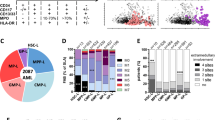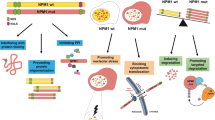Abstract
NPM1-mutated AML is one of the largest entities in international classification systems of myeloid neoplasms, which are based on integrating morphologic and clinical data with genomic data. Previous research, however, indicates that bulk transcriptomics-based subtyping may improve prognostication and therapy guidance. Here, we characterized the heterogeneity in NPM1-mutated AML by performing single-cell RNA-sequencing and spectral flow cytometry on 16 AML belonging to three distinct subtypes previously identified by bulk transcriptomics. Using single-cell expression profiling we generated a comprehensive atlas of NPM1-mutated AML, collectively reconstituting complete myelopoiesis. The three NPM1-mutated transcriptional subtypes showed consistent differences in the proportions of myeloid cell clusters with distinct patterns in lineage commitment and maturational arrest. In all samples, leukemic cells were detected across different myeloid cell clusters, indicating that NPM1-mutated AML are heavily skewed but not fully arrested in myelopoiesis. Same-sample multi-color spectral flow cytometry recapitulated these skewing patterns, indicating that the three NPM1-mutated subtypes can be consistently identified across platforms. Moreover, our analyses highlighted differences in the abundance of rare hematopoietic stem cells suggesting that skewing occurs early in myelopoiesis. To conclude, by harnessing single-cell RNA-sequencing and spectral flow cytometry, we provide a detailed description of three distinct and reproducible patterns in lineage skewing in NPM1-mutated AML that may have potential relevance for prognosis and treatment of patients with NPM1-mutated AML.

This is a preview of subscription content, access via your institution
Access options
Subscribe to this journal
Receive 12 print issues and online access
$259.00 per year
only $21.58 per issue
Buy this article
- Purchase on SpringerLink
- Instant access to full article PDF
Prices may be subject to local taxes which are calculated during checkout




Similar content being viewed by others
Data availability
All single-cell RNA-sequencing data was submitted to EGA with the accession number EGAS50000000332, and they are accessible upon request (due to privacy rules). Processed version of the scRNA-seq data for all 16 NPM1-mutated AML samples were uploaded to Figshare under the https://doi.org/10.6084/m9.figshare.26189771.
Code availability
All source codes are available at https://github.com/eonurk/scNPM1. Our AML variant calling pipeline for single-cell RNA-seq data is also open-sourced and available under the same repository.
References
Khoury JD, Solary E, Abla O, Akkari Y, Alaggio R, Apperley JF, et al. The 5th edition of the World Health Organization classification of haematolymphoid tumours: myeloid and histiocytic/dendritic neoplasms. Leukemia. 2022;36:1703–19.
Arber DA, Orazi A, Hasserjian RP, Borowitz MJ, Calvo KR, Kvasnicka H-M, et al. International Consensus Classification of Myeloid Neoplasms and Acute Leukemias: integrating morphologic, clinical, and genomic data. Blood. 2022;140:1200–28.
Falini B, Brunetti L, Sportoletti P, Martelli MP. NPM1-mutated acute myeloid leukemia: from bench to bedside. Blood. 2020;136:1707–21.
Papaemmanuil E, Gerstung M, Bullinger L, Gaidzik VI, Paschka P, Roberts ND, et al. Genomic classification and prognosis in acute myeloid leukemia. N Engl J Med. 2016;374:2209–21.
Severens JF, Karakaslar EO, Van Der Reijden BA, Sánchez-López E, Van Den Berg RR, Halkes CJM et al. Mapping AML heterogeneity - multi-cohort transcriptomic analysis identifies novel clusters and divergent ex-vivo drug responses. Leukemia. 2024. https://doi.org/10.1038/s41375-024-02137-6.
Mer AS, Heath EM, Madani Tonekaboni SA, Dogan-Artun N, Nair SK, Murison A, et al. Biological and therapeutic implications of a unique subtype of NPM1 mutated AML. Nat Commun. 2021;12:1054.
Cheng W-Y, Li J-F, Zhu Y-M, Lin X-J, Wen L-J, Zhang F, et al. Transcriptome-based molecular subtypes and differentiation hierarchies improve the classification framework of acute myeloid leukemia. Proc Natl Acad Sci USA. 2022;119:e2211429119.
Giacopelli B, Wang M, Cleary A, Wu Y-Z, Schultz AR, Schmutz M, et al. DNA methylation epitypes highlight underlying developmental and disease pathways in acute myeloid leukemia. Genome Res. 2021;31:747–61.
Karakaslar EO, Severens JF, Sánchez-López E, van Veelen PA, Zlei M, van Dongen JJM, et al. A transcriptomic based deconvolution framework for assessing differentiation stages and drug responses of AML. npj Precis Oncol. 2024;8:105.
Beneyto-Calabuig S, Merbach AK, Kniffka J-A, Antes M, Szu-Tu C, Rohde C, et al. Clonally resolved single-cell multi-omics identifies routes of cellular differentiation in acute myeloid leukemia. Cell Stem Cell. 2023;30:706–721.e8.
Nam AS, Dusaj N, Izzo F, Murali R, Myers RM, Mouhieddine TH, et al. Single-cell multi-omics of human clonal hematopoiesis reveals that DNMT3A R882 mutations perturb early progenitor states through selective hypomethylation. Nat Genet. 2022;54:1514–26.
van Galen P, Hovestadt V, Wadsworth II MH, Hughes TK, Griffin GK, Battaglia S, et al. Single-cell RNA-Seq reveals AML hierarchies relevant to disease progression and immunity. Cell. 2019;176:1265–1281.e24.
Naldini MM, Casirati G, Barcella M, Rancoita PMV, Cosentino A, Caserta C, et al. Longitudinal single-cell profiling of chemotherapy response in acute myeloid leukemia. Nat Commun. 2023;14:1285.
Triana S, Vonficht D, Jopp-Saile L, Raffel S, Lutz R, Leonce D, et al. Single-cell proteo-genomic reference maps of the hematopoietic system enable the purification and massive profiling of precisely defined cell states. Nat Immunol. 2021;22:1577–89.
Hao Y, Hao S, Andersen-Nissen E, Mauck WM, Zheng S, Butler A, et al. Integrated analysis of multimodal single-cell data. Cell. 2021;184:3573–3587.e29.
McGinnis CS, Murrow LM, Gartner ZJ. DoubletFinder: doublet detection in single-cell RNA sequencing data using artificial nearest neighbors. Cell Syst. 2019;8:329–337.e4.
Zappia L, Oshlack A. Clustering trees: a visualization for evaluating clusterings at multiple resolutions. GigaScience. 2018;7:https://doi.org/10.1093/gigascience/giy083.
Suo C, Dann E, Goh I, Jardine L, Kleshchevnikov V, Park J-E, et al. Mapping the developing human immune system across organs. Science. 2022;376:eabo0510.
Tyner JW, Tognon CE, Bottomly D, Wilmot B, Kurtz SE, Savage SL, et al. Functional genomic landscape of acute myeloid leukaemia. Nature. 2018;562:526–31.
Pianigiani G, Rocchio F, Peruzzi S, Andresen V, Bigerna B, Sorcini D, et al. The absent/low expression of CD34 in NPM1-mutated AML is not related to cytoplasmic dislocation of NPM1 mutant protein. Leukemia. 2022;36:1931–4.
Ng SWK, Mitchell A, Kennedy JA, Chen WC, McLeod J, Ibrahimova N, et al. A 17-gene stemness score for rapid determination of risk in acute leukaemia. Nature. 2016;540:433–7.
Levine JH, Simonds EF, Bendall SC, Davis KL, Amir ED, Tadmor MD, et al. Data-driven phenotypic dissection of AML reveals progenitor-like cells that correlate with prognosis. Cell. 2015;162:184–97.
Lewis JE, Hergott CB. The immunophenotypic profile of healthy human bone marrow. Clin Lab Med. 2023;43:323–32.
Foster BM, Zaidi D, Young TR, Mobley ME, Kerr BA. CD117/c-kit in cancer stem cell-mediated progression and therapeutic resistance. Biomedicines. 2018;6:31.
Córbi AL, Lopéz-Rodríguez C. CD11c integrin gene promoter activity during myeloid differentiation. Leuk Lymphoma. 1997;25:415–25.
Zeng AGX, Bansal S, Jin L, Mitchell A, Chen WC, Abbas HA, et al. A cellular hierarchy framework for understanding heterogeneity and predicting drug response in acute myeloid leukemia. Nat Med. 2022;28:1212–23.
Kuusanmäki H, Kytölä S, Vänttinen I, Ruokoranta T, Ranta A, Huuhtanen J, et al. Ex vivo venetoclax sensitivity testing predicts treatment response in acute myeloid leukemia. Haematologica. 2023;108:1768–81.
Pei S, Pollyea DA, Gustafson A, Stevens BM, Minhajuddin M, Fu R, et al. Monocytic subclones confer resistance to venetoclax-based therapy in patients with acute myeloid leukemia. Cancer Discov. 2020;10:536–51.
White BS, Khan SA, Mason MJ, Ammad-ud-din M, Potdar S, Malani D, et al. Bayesian multi-source regression and monocyte-associated gene expression predict BCL-2 inhibitor resistance in acute myeloid leukemia. npj Precis Onc. 2021;5:71.
Figueroa ME, Abdel-Wahab O, Lu C, Ward PS, Patel J, Shih A, et al. Leukemic IDH1 and IDH2 mutations result in a hypermethylation phenotype, disrupt TET2 function, and impair hematopoietic differentiation. Cancer Cell. 2010;18:553–67.
Kersten B, Valkering M, Wouters R, Van Amerongen R, Hanekamp D, Kwidama Z, et al. CD 45 RA, a specific marker for leukaemia stem cell sub-populations in acute myeloid leukaemia. Br J Haematol. 2016;173:219–35.
Caliskan G, Pawitan Y, Vu TN. Similarities and differences of bone marrow and peripheral blood samples from acute myeloid leukemia patients in terms of cellular heterogeneity and ex-vivo drug sensitivity. eJHaem. 2024;5:721–7.
Acknowledgements
Authors would like to thank Peter van Balen for his help on data acquisition and transfer, and Leon Mei and Davy Cats for their help on data upload. This study received financial support from a strategic investment from the Leiden University Medical Center, integrated within the Leiden Oncology Center and conducted within the Leiden Center for Computational Oncology, and partly by the Dutch Cancer Society (project number 15152). EBA was supported by a personal grant from the Dutch Research Council (NWO; VENI: 09150161810095). The funding entities played no part in determining the study’s design, data collection, analysis, interpretation, manuscript composition, or the decision to submit it for publication. BioRender icons were used in graphical abstract, Figs. 1a and 3a.
Author information
Authors and Affiliations
Contributions
EBA, MG, MJTR designed the project; EBA acquired funding; EMA, NES, MG, SK and HV helped with data generation and transfer; EOK, EMA performed computational and statistical analyses; EOK created all figures; EOK, RSHZ implemented variant calling pipeline; EOK, EMA, RSHZ, JFS, EBA, MG, and MJTR supported data exploration and interpretation; MJTR, MG and EBA provided supervision and scientific direction; EOK, EBA and MG wrote the manuscript; and all authors critically reviewed the manuscript and figures.
Corresponding authors
Ethics declarations
Competing interests
The authors declare no competing interests.
Ethics approval and consent to participate
All methods were performed in accordance with the relevant guidelines and regulations, including the Declaration of Helsinki. Approval to use NPM1-mutated AML patient samples for this research was obtained from the Leiden University Medical Center (LUMC) Institutional Review Board (protocol no. RP24.056). Written informed consent to participate was obtained from all participants prior to sample collection.
Additional information
Publisher’s note Springer Nature remains neutral with regard to jurisdictional claims in published maps and institutional affiliations.
Rights and permissions
Springer Nature or its licensor (e.g. a society or other partner) holds exclusive rights to this article under a publishing agreement with the author(s) or other rightsholder(s); author self-archiving of the accepted manuscript version of this article is solely governed by the terms of such publishing agreement and applicable law.
About this article
Cite this article
Karakaslar, E.O., Argiro, E.M., Struckman, N.E. et al. Resolving inter- and intra-patient heterogeneity in NPM1-mutated AML at single-cell resolution. Leukemia (2025). https://doi.org/10.1038/s41375-025-02745-w
Received:
Revised:
Accepted:
Published:
DOI: https://doi.org/10.1038/s41375-025-02745-w



